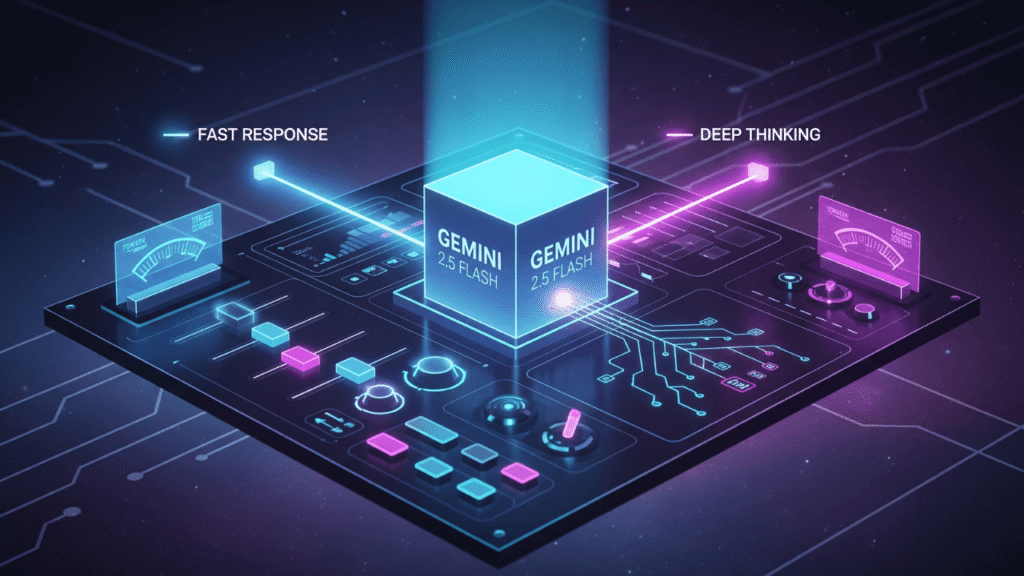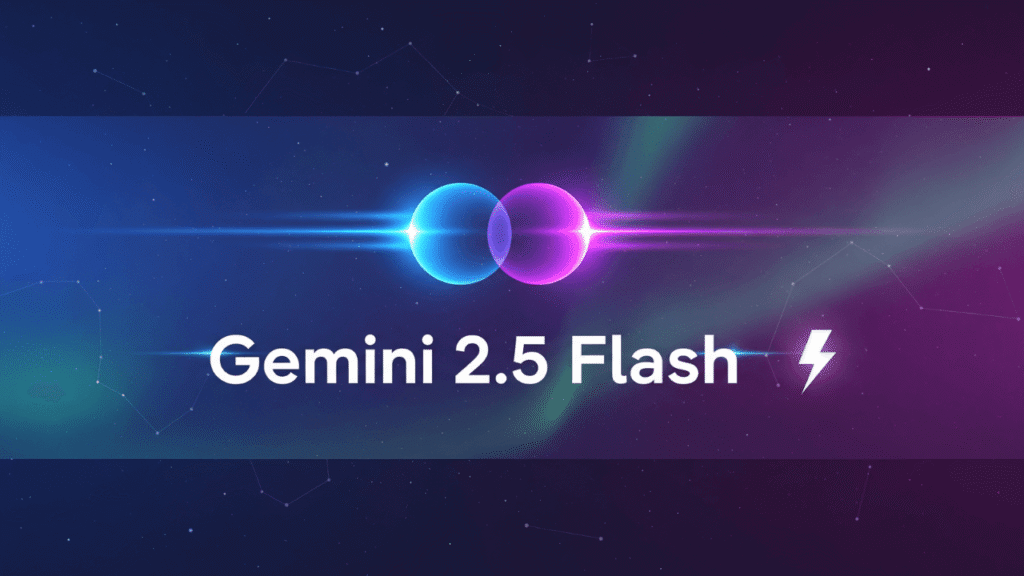Google is rolling out Gemini 2.5 Flash inside the Gemini app, opening the doors for everyday users to try the company’s latest model while it’s still in preview. Think of it as the brighter, lighter successor to 2.0 Flash—built for speed and efficiency—arriving at a moment when Google is turning up the heat on rivals like OpenAI and Anthropic. API users get a bonus here too: the company is positioning 2.5 Flash to be cheaper to run than competing models, which is exactly the kind of lever developers watch closely.
Back in 2023, Gemini (formerly Bard) stumbled out of the gate. By early to mid-2025, though, the story is very different. The results are stronger, the model lineup is broader, and the release cadence is relentless. New entries pop up in the Gemini app and in developer tools like AI Studio almost weekly. The latest is Gemini 2.5 Flash—faster, more efficient, and still very much in preview.
Too many models, too little time? The Gemini app problem
Open the model selector in the Gemini app and you’ll see the challenge: so many options that the dropdown can feel like a maze. It’s a “good problem,” sure, but a problem nonetheless—one that OpenAI’s ChatGPT users also know well. With preview models everywhere and new ways to use Gemini rolling out constantly, picking the right tool for a given task can take a minute.
Inside Google, Tulsee Doshi—director of product management for Gemini and a leader on the team building these models—says she leans on the more powerful Gemini 2.5 Pro, especially for writing assistance. By contrast, the new 2.5 Flash is dramatically smaller than 2.5 Pro and roughly the size of 2.0 Flash, yet aimed to perform better. Doshi calls it a “major improvement” over 2.0 Flash. To keep the lineup clearer in the app and on the web, it’ll appear as 2.5 Flash (Experimental), replacing the 2.0 Thinking (Experimental) slot. That swap should reduce at least some of the confusion.
Also Read
Reasoning when you need it—without wasting cycles

All models in the 2.5 branch and beyond come with built-in simulated reasoning—Google calls it “thinking.” In practical terms, that means the model checks itself during generation to produce more accurate results. The trade-off? Extra time and higher cost. Not every prompt justifies that overhead, and that’s where the new 2.5 Flash approach stands out: it lets developers dial the “thinking” up or down to suit the task.
Worth noting: the earlier 2.0 Thinking model never graduated from experimental status, a reminder of how quickly the Gemini team is moving. The new approach in 2.5 is dynamic—the model “thinks” more or less based on the input it’s given. It’s similar in spirit to what Claude 3.7 Sonnet does; Anthropic’s CEO Dario Amodei has described this as a “spectrum” of reasoning intensity. The advantage is simple: by matching the depth of analysis to the complexity of the request, you avoid burning compute on easy questions and save the heavy lift for prompts that actually need it.
Dynamic Thinking in Gemini 2.5 Flash
Here’s where 2.5 Flash goes a step further. Like 2.5 Pro, it supports Dynamic Thinking, automatically scaling the work required to produce an answer. But Flash adds developer control to the mix. You can set a token budget for “thinking” or turn it off entirely. That means teams can govern both behavior and cost—use a generous reasoning allowance on mission-critical steps, then clamp it down elsewhere to keep performance snappy and bills predictable.
Google’s pricing guidance for the preview underscores the flexibility. Input is listed at $0.15 per million tokens. Output comes in two bands: $0.60 per million tokens with “thinking” disabled, and $3.50 per million tokens with “thinking” enabled. The “thinking budget” slider lets developers tune exactly how much reasoning to spend on a given task. As Doshi frames it, give the model more tokens to think, and you’ll see corresponding gains on benchmarks—evidence that the additional analysis is doing real work.
A model lineup that’s evolving fast
If you’re keeping score, Gemini 2.5 Pro remains available—and also remains experimental—while 2.0 Flash is still the only non-experimental chatbot in the lineup. That older Flash model sits at the minimal end of the reasoning spectrum (or, as some would put it, well to the left of the kind of heavy-duty “thinking” steps you’d associate with something like o3 on the far right).
The new 2.5 Flash aims to be the sweet spot: compact and fast like the 2.0 Flash era, but smarter and more adaptable thanks to Dynamic Thinking and the new developer controls. In short, it’s designed to be the everyday workhorse you can tune for precision when you need it.
Easier to use: Canvas support now, “deep research” later
Usability matters just as much as raw capability. Unlike the 2.0 Thinking model, 2.5 Flash directly supports Google’s Canvas—the workspace for iterating on text and code. That enables a more fluid loop for drafting, refining, and testing inside the same environment. A Google spokesperson says support for “deep research” with this model is planned for later, which will extend where Flash can be used without switching contexts.
Picking the right model for the job
With all these options, how do you choose? Doshi notes that 2.5 Pro is a strong companion for tasks like writing assistance, where you want the heft of a larger model. 2.5 Flash is the leaner, speed-first option that can still flex when a prompt gets gnarly—thanks to Dynamic Thinking and a reasoning budget you control. And if you need a model in non-experimental status for production chat today, 2.0 Flash remains your stable, no-frills pick.
This broader context is part of a larger industry rhythm—yes, OpenAI is shipping its own updates (including o3 and o4-mini), and Anthropic continues to refine its Claude family. The point is not a scoreboard; it’s that developers and end users are being handed clearer choices that map to real-world needs: cost, speed, reasoning depth, and tool support.
Developer-first controls: tuning cost and quality
The headline feature for developers is control. Set a “thinking” token limit if you want bounded costs with predictable behavior. Disable “thinking” entirely when you’re dealing with straightforward extraction, formatting, or quick classification. Or let Dynamic Thinking automatically scale the effort based on the prompt and let the model decide how much analysis is warranted.
Google began collecting developer interest in 2.5 Flash earlier this month. Even though the model isn’t fully finalized, the company is making it available in Vertex AI and AI Studio with variable API pricing. That early access is by design: Google wants feedback on how well the model matches developer expectations and where it may under-think or over-think. That signal will drive the next round of iterations on Dynamic Thinking so the model spends its “brainpower” where it’s genuinely useful.
The practical upside of dynamic reasoning
Let’s ground this in everyday scenarios. If you’re building a feature that summarizes short, structured updates, spending tokens on deep reasoning is unnecessary overhead. Flip “thinking” off, keep output at the lower cost tier, and return results fast. If you’re analyzing a messy prompt with ambiguous instructions and multiple constraints, turn “thinking” on and grant a larger token budget. The model will walk through more checks as it composes the answer—trading time and cost for quality and consistency.
Because that reasoning step happens during generation, it can reduce the back-and-forth you’d otherwise have to code around—like running a second pass to verify an answer, or imposing extra validation layers to catch obvious misreads. You’re still going to build guardrails, of course, but the dynamic approach helps right-size the effort up front.
Availability today—and what’s next
You can explore Gemini 2.5 Flash in the Gemini app right now in its Experimental form. Developers will find it in Vertex AI and AI Studio as well, with the pricing tiers that correspond to input tokens and output with or without “thinking.” Meanwhile, Gemini 2.5 Pro continues in preview, and 2.0 Flash remains the only non-experimental chatbot in the stack.
Given how quickly Google’s team has been shipping, a finalized 2.5 family doesn’t feel far away. There aren’t firm dates or additional specifics yet, but with new developer controls, Canvas support, and the app-level availability, the direction is clear. As Doshi puts it, the goal is to take what’s landing in preview and make the 2.5 family generally available once the feedback loop has run its course.
Bottom line
Gemini 2.5 Flash is about control and efficiency: the speed of a compact model, the brains of dynamic reasoning, and a pricing structure that lets you decide how much “thinking” you want to buy. It replaces older experimental slots in the app, supports Canvas out of the gate, and gives builders a dial they can actually use in production—turning the abstract debate about “reasoning” into a concrete choice about cost, latency, and accuracy.
If you’ve been waiting for a model that handles quick tasks without drama but can still gear up when your prompts demand it, 2.5 Flash is that everyday tool—preview today, built to be tuned tomorrow.





